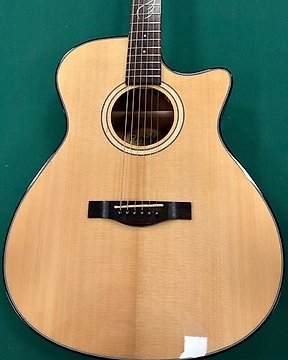
FARIDA - A 6c-na - - Guitare acoustique
Nº 85780077

Nº 85780077

Instrument overview:
1. Wood Type and Quality:
• The bow is made of high-quality pernambuco wood, which is known for its superior elasticity and density, making it an ideal material for bow making.
2. Frog and Button:
• The frog is crafted from ebony, featuring a simple and elegant design. It appears to be a Baroque-style frog, which is more extended compared to modern frogs. The button is also made of ebony, with a turned finial, common in Baroque and transitional bows.
3. Grip:
• The bow lacks a traditional grip or winding, consistent with historical Baroque and early transitional bows. This absence allows for a different balance and feel compared to modern bows.
4. Hair:
• The hair on the bow is white horsehair, which is standard for high-quality bows. It appears well-distributed and appropriately tensioned.
5. Tip:
• The tip of the bow is finely carved, showing careful attention to detail. It follows a more slender profile typical of Baroque and early classical period bows, designed for a lighter, more articulate playing style.
6. Interesting Features:
• The extended frog and lack of a grip are uncommon in modern bows but are characteristic of period bows.
• The overall shape and balance suggest a design intended to replicate historical playing techniques.
7. Stamp:
• There is no visible stamp on the bow.
8. Damage:
• There is no visible damage to the bow. The wood IS smooth and well-maintained, and the horsehair is in good condition.
History and details
1. Construction Style and Methods:
• The bow is built using traditional methods associated with Baroque and early Classical bows. This involves hand-crafting the pernambuco wood, shaping it to achieve the desired flexibility and strength. The frog and button are also hand-carved, typically from ebony, and are designed to be more extended compared to modern counterparts.
2. Influences:
• The design of the bow is influenced by the early bow makers such as François Tourte, who is often credited with refining the bow shape and balance during the late 18th century. However, this bow leans more towards the earlier Baroque style, with a simpler frog and lack of metal fittings.
• The absence of a grip or winding is indicative of bows made during the Baroque period, where players relied more on the natural feel of the wood.
3. Style:
• This bow is built in the Baroque style, characterized by its lighter weight, extended frog, and slender tip. These features were designed to produce a lighter, more articulate sound suitable for the performance practices of the 17th and 18th centuries.
• The elongated frog and simple, turned button reflect the aesthetic and functional design preferences of the Baroque period.
6. Based On:
• The bow is likely based on the designs of early makers like François Tourte or other contemporaneous artisans who helped shape the development of the bow during the transition from the Baroque to the Classical period. The maker would have studied historical bows, drawings, and methods to recreate an instrument faithful to the period.
Measurements:
Total length: 70 cm (estimate)
Weight bow: 60 gram (estimate)
Packaging and Shipping:
Our commitment extends beyond the auction. The bow will be professionally packaged and shipped within 3 workdays after payment, to ensure its safe journey to your doorstep. PostNL/DHL/DPD/UPS shipping options are available, tailored to your location you will always get the cheapest option, worldwide.
We understand the importance of a seamless process, and our team is dedicated to making your acquisition a worry-free experience.
Warranty:
Your satisfaction is important to us. This bow comes with a full warranty as per Catawiki’s terms and conditions.
Notice:
Pictures in this auction are part of the description.
Comment acheter sur Catawiki ?
1. Découvrez des objets d’exception
2. Faites la meilleure offre
3. Effectuez un paiement sécurisé